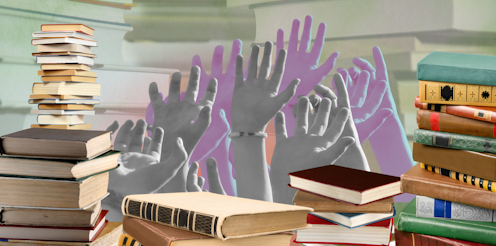Editors have long been publishing's hidden handmaidens – what might we gain if we acknowledged their role?
- Written by Alice Grundy, PhD Candidate, Australian National University

Editors are almost always unseen and unheard – until something goes wrong. That might be a relatively minor mistake, such as a typo – as in a cookbook that mistakenly listed “people” instead of “pepper” in a recipe[1]. Or it could be more substantial questions about the integrity of a book’s contents.
In 2018, Clinton Walker’s Deadly Woman Blues: Black Women & Australian Music was withdrawn from the market by its publisher, NewSouth, after it drew criticism from artists featured in the book. Aaron Corn and Marcia Langton asked in The Conversation[2], “How were its many obvious flaws permitted to go to press?”.
What is it exactly that we expect from editors? And are they starting to come out from behind the curtain?
Having worked in publishing for 15 years, a major change I’ve witnessed recently is the centring of ethical questions in discussions of editorial labour – from sensitivity reads[3] intended to vet books for material that may cause offense, to editors protesting[4] the publication of a contentious author’s work.
Editing is no longer a private task that one person performs on the writing of another. Then again, it never really was – Medievalists have long recognised the collaborations[5] that underpin the publishing process, it’s only since the Romantic period, starting around the end of the 18th century, that we have glorified the lone author.
Reasons for keeping the editor’s work invisible have changed over time. The idea of the single author as solely responsible can be read as a result of the introduction of copyright law[6] and a convenience for publishers[7]. In what Dan Sinykin calls “the conglomerate era”[8] (referring to the rise of the behemoth multinational publishers since the second world war), an invisible editor has become part of a general need to mask the workings of a publishing company that conflict with romantic notions of books and their creation.
But what are the consequences of having an invisible editorial workforce? And is it time for change?
Read more: 'The entire industry is based on hunches': is Australian publishing an art, a science or a gamble?[9]
Editors as midwives
I don’t think it’s a coincidence that metaphors associated with editing are feminine – the most common identifies the editor as the midwife and the book as the baby. As a recent University of Melbourne survey[10] showed, publishing workers are more likely to be female, white, have attended a private school and have poorer mental health than the national average.
For those in the industry, this is less a surprise than a confirmation of what we already knew. Being widely read, prepared to accept a low salary and taking on a kind of service role all align with this profile.
Another recent survey[11] has shown wages are low (compared with teachers, not compared with lawyers). And that the gender gap between the (female dominated) lower levels of the workforce and (male dominated) upper levels persist. There has been an increase in gender non-binary staff since 2018, when Books and Publishing last conducted the survey – but this number remains small.
The survey also made clear that wages are decreasing in real terms. It reported a two per cent pay rise for editors in this time. The CPI has increased by 13.9 %[12].
A number of Australian publishing companies are privately owned (including Allen & Unwin, Text and Scribe), so their financials are not publicly available. But for multinational HarperCollins, global revenue grew 10% in 2022[13] to US$2.2 billion. Penguin Random House’s global revenue grew to €1.92 billion[14]. Both companies make profits in the hundreds of millions of dollars.
Book publishing has continued to be profitable in recent years, compared with some other media businesses, such as newspapers, which have suffered considerably with changes to advertising revenue and the shifts to digital habits.
With continued robust income – even in the face of contemporary pressures such as supply-chain interruptions – why do publishing staff wages remain low? Could editors’ invisible labour be one of the reasons?
Invisible mending
When editors speak about their work publicly, discussions are often bookended by comments around the importance of invisibility. Australia’s most celebrated editor, Beatrice Davis, who worked with some of the best-known authors of the second half of the 20th century, emphasised “invisible mending”. Davis, and other editors, insisted on the importance of keeping their work hidden for a few reasons – the greatest of which was maintaining the author’s confidence.
This is a persuasive argument for two reasons. Firstly, and self-evidently, it is the author’s name on the spine and their personal reputation at stake. Secondly, even though publishers are sometimes embroiled in legal proceedings [15] over the content of their books, many publishers include a clause in their boilerplate contracts putting responsibility for the content with the author.

















